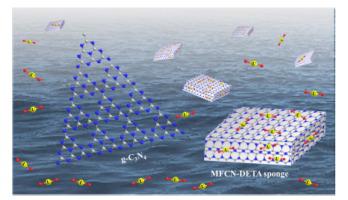Journal of Molecular Liquids ( IF 5.3 ) Pub Date : 2021-09-20 , DOI: 10.1016/j.molliq.2021.117238 Jiahui Zhu 1, 2 , Xuan Hao 1, 2 , Qi Liu 1, 2, 3 , Jingyuan Liu 1, 2 , Rongrong Chen 1, 2, 4 , Jing Yu 1, 2 , Rumin Li 1, 2, 5 , Peili Liu 1, 2, 4 , Jun Wang 1, 2, 4, 5

|
Uranium is the key fuel for nuclear power and there is 4.5 billion tons of uranium in the oceans. However, it is a significant challenge for the current adsorbent with powder form to extract uranium from seawater. In this study, we report a facile method for the synthesis of three-dimensional macroscopic g-C3N4 sponge from melamine-formaldehyde (MFCN) resin by thermal polymerization, which can easily be extracted from aqueous solution. Different organic amino (diethylenetriamine, triethylenetetramine and tetraethylenepentamine) modified g-C3N4 sponge composites (MFCN-DETA, MFCN-TETA and MFCN-TEPA) has been designed by schiff base reaction. The uranium adsorption performance of the products from aqueous solutions and simulated seawater was investigated. MFCN, MFCN-DETA and MFCN-TEPA achieved the maximum adsorption capacity at pH 6 and the optimum pH for MFCN-TETA was 5.0. The results showed that the maximum adsorption capacity of MFCN-DETA composites was 658.57 mg/g at pH 6. Furthermore, the MFCN-DETA composites was effectively regenerated using 0.1 N HNO3, which could be reused for enrichment of uranium (VI) and the adsorption efficiency could maintain 83% after 5 cycles of adsorption and desorption. The distribution coefficie(Kd) value of uranium was 9.1 × 104 mL g−1 for MFCN-DETA in simulating seawater. Thus, MFCN-DETA composites are believed to have promising potential applications in removal of uranium (VI) from seawater.
中文翻译:

探索氨基官能化三维宏观g-C3N4海绵在提高铀回收率中的应用
铀是核能的关键燃料,海洋中蕴藏着 45 亿吨铀。然而,对于目前的粉末形式的吸附剂来说,从海水中提取铀是一项重大挑战。在这项研究中,我们报告了一种通过热聚合从三聚氰胺甲醛 (MFCN)树脂合成三维宏观 gC 3 N 4海绵的简便方法,该 树脂可以很容易地从水溶液中提取。不同有机氨基(二亚乙基三胺、三亚乙基四胺和四亚乙基五胺)改性的 gC 3 N 4海绵复合材料(MFCN-DETA、MFCN-TETA 和 MFCN-TEPA)是通过席夫碱反应设计的。研究了来自水溶液和模拟海水的产物对铀的吸附性能。MFCN、MFCN-DETA 和 MFCN-TEPA 在 pH 值为 6 时达到最大吸附容量,MFCN-TETA 的最适 pH 值为 5.0。结果表明,MFCN-DETA 复合材料在 pH 6 时的最大吸附容量为 658.57 mg/g。此外,使用 0.1 N HNO 3对 MFCN-DETA 复合材料进行了有效再生,可重复用于铀 (VI) 的浓缩和经过5次吸附和解吸循环后,吸附效率可保持83%。铀的分布系数(K d)值为 9.1 × 10 4 mL g -1MFCN-DETA 模拟海水。因此,人们认为 MFCN-DETA 复合材料在从海水中去除铀 (VI) 方面具有潜在的应用前景。











































 京公网安备 11010802027423号
京公网安备 11010802027423号